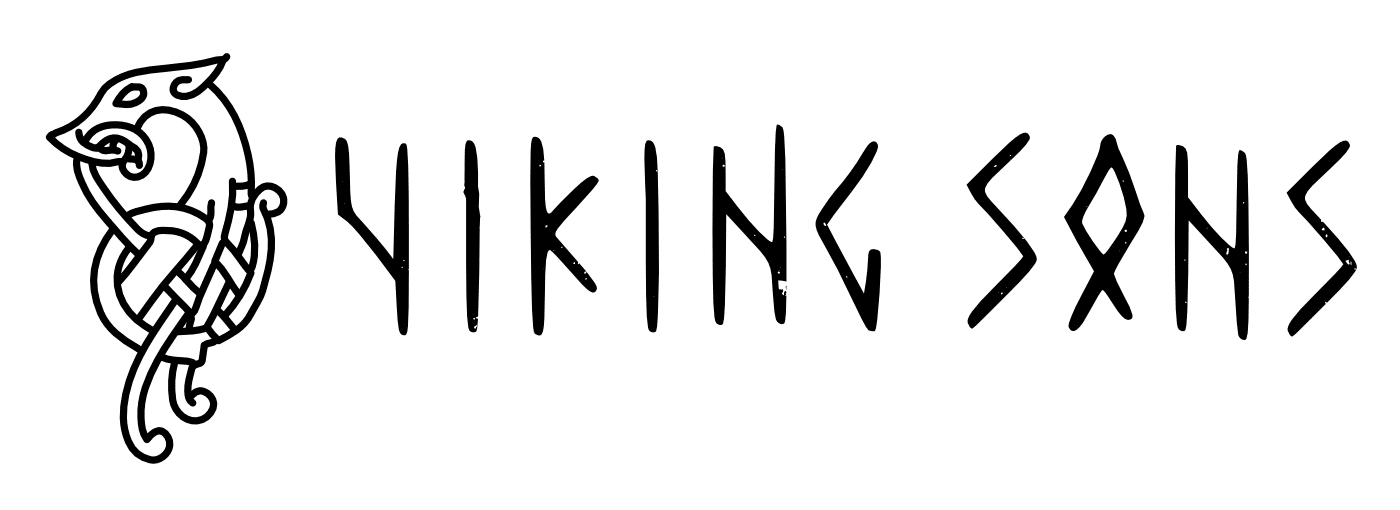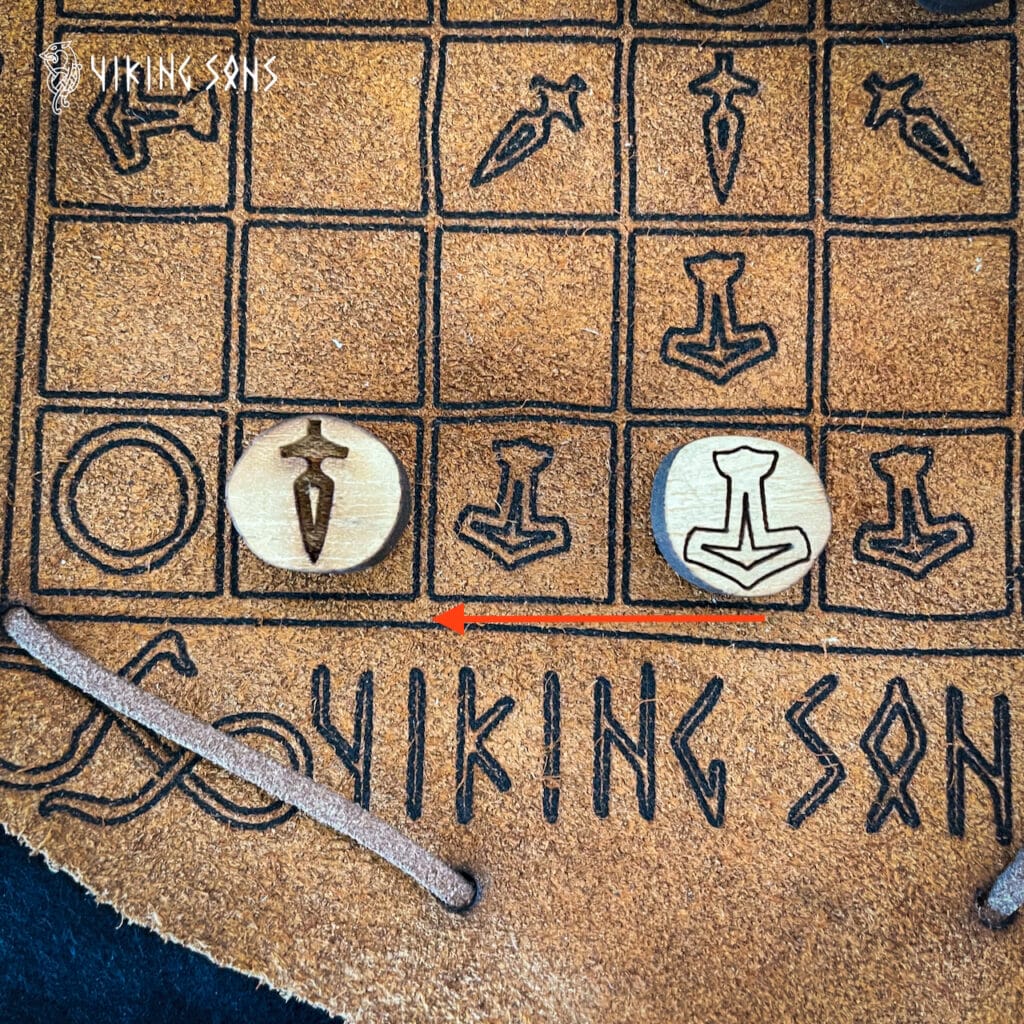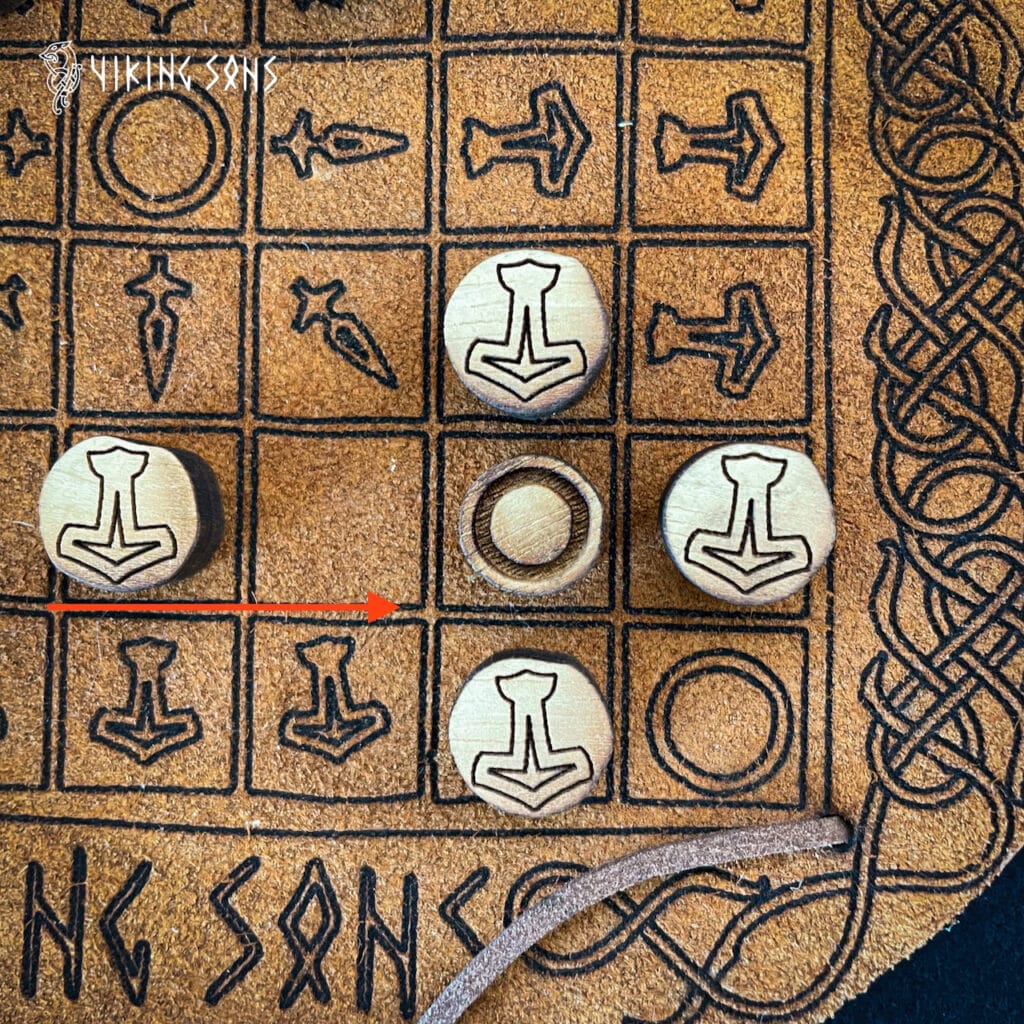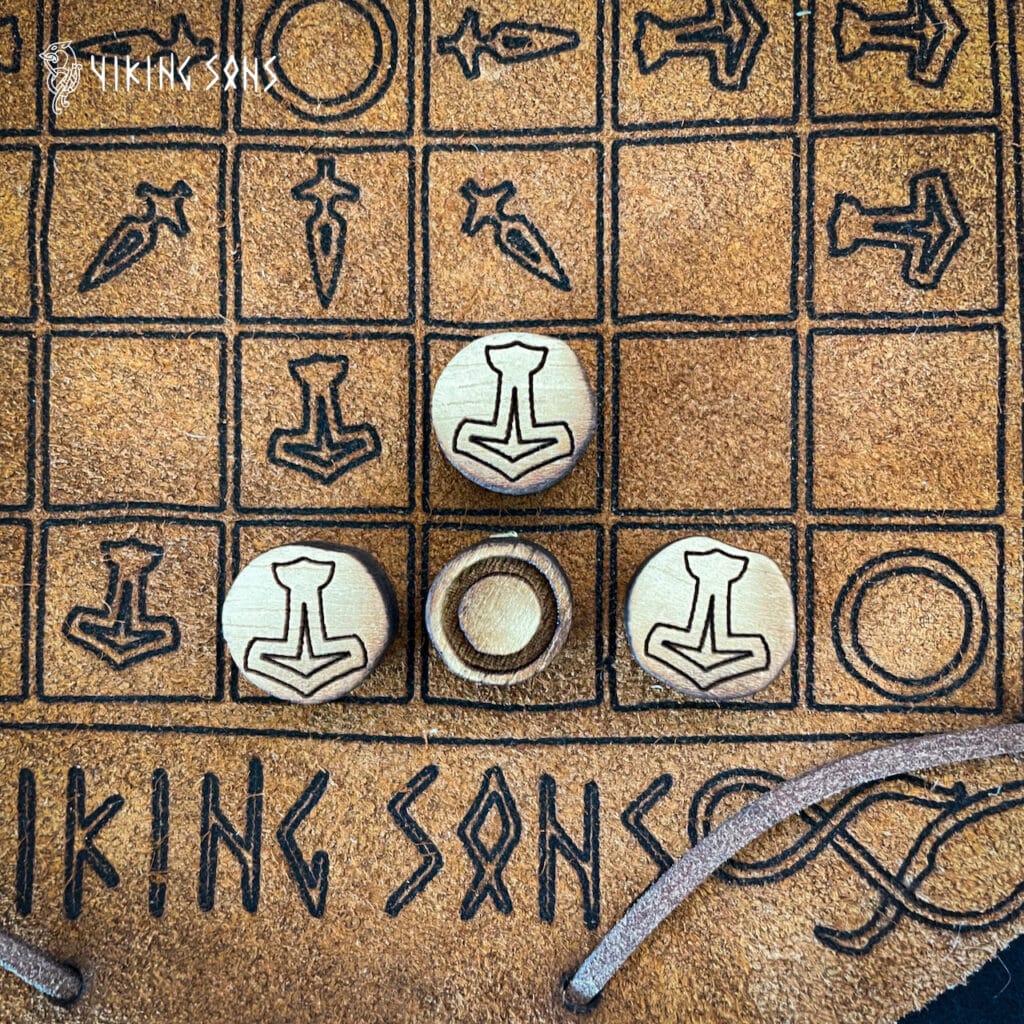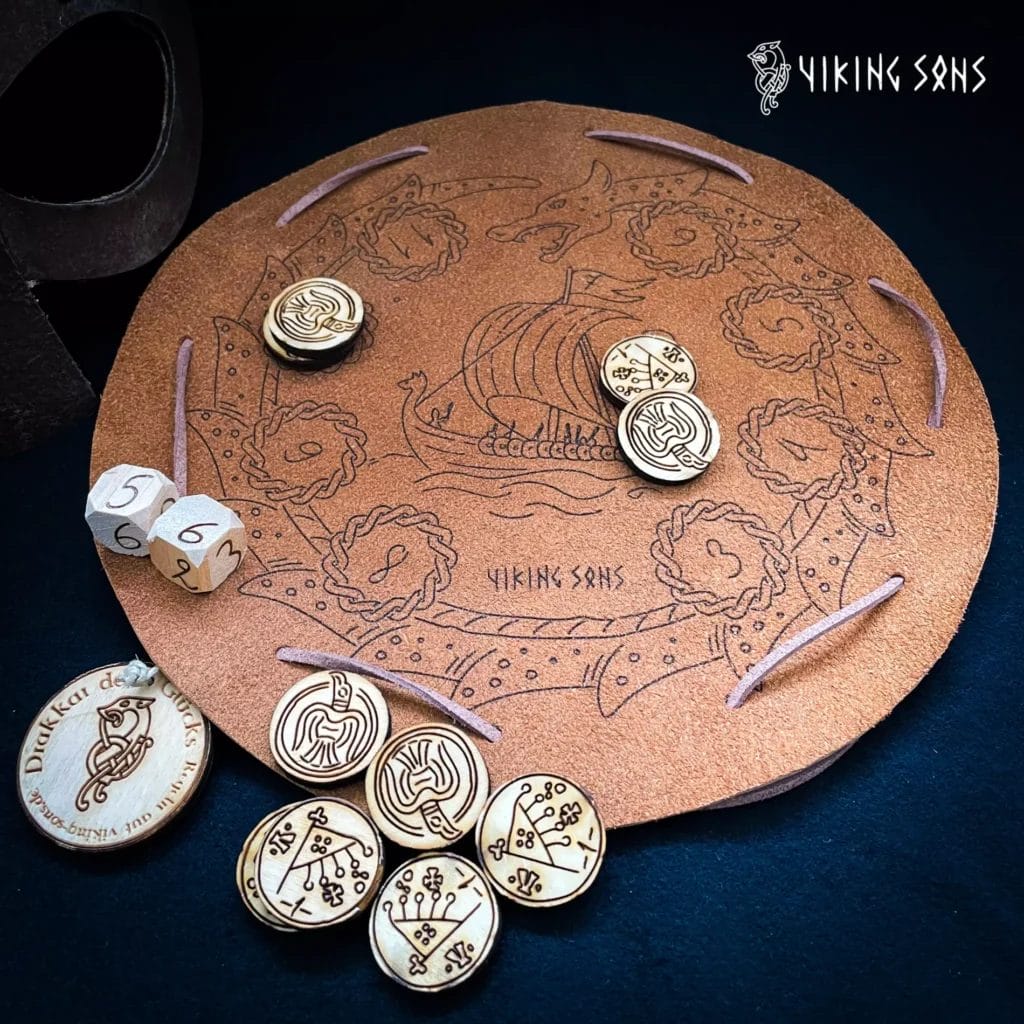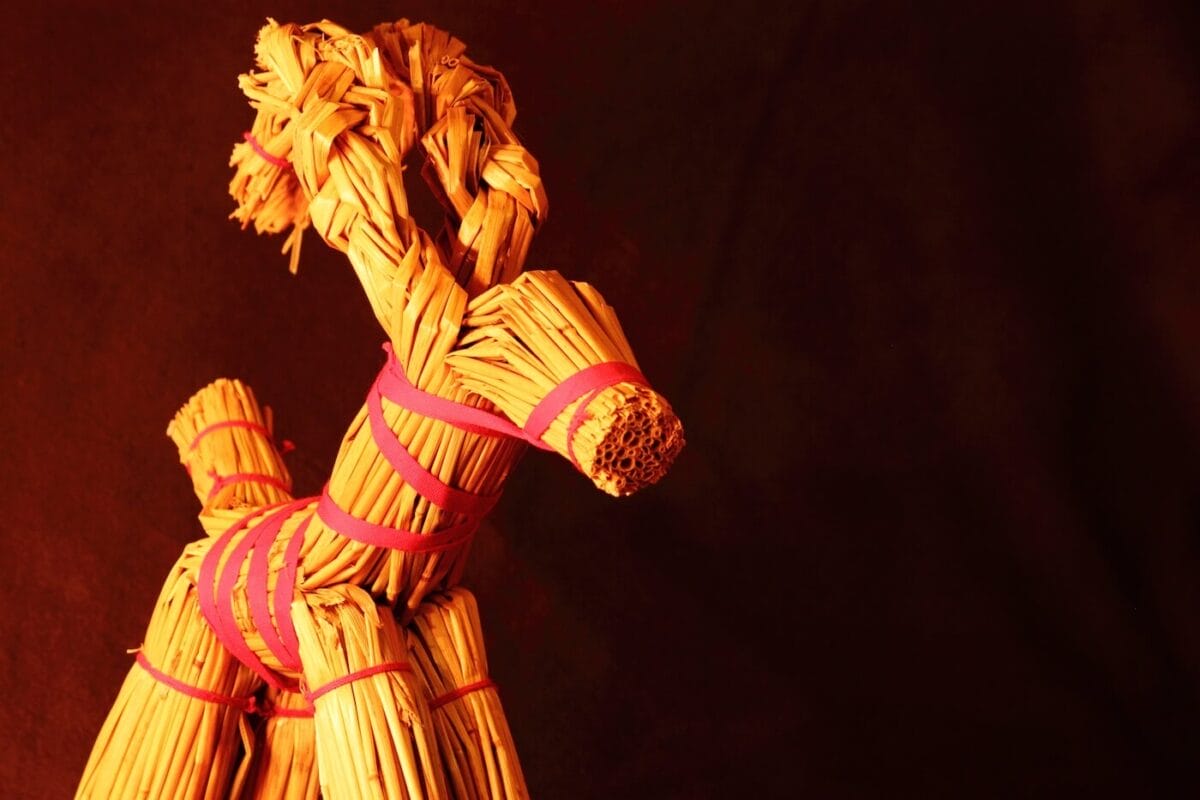Hnefatafl, which means King’s Table in Old Norse, is an asymmetrical, purely strategic game. It was played by the Vikings, the Scandinavian and British peoples. Here you can read the rules for Hneftafl, the game of the Vikings.
What is the Hnefatafl?
Its origins are unclear, but it seems to have originated and been played in the Viking Age, in the 7th or 8th century AD, in Scandinavia and other countries conquered by the Vikings. Archaeological finds exist mainly in the Baltic region, the British Isles and Iceland. In addition to Hnefatafl, many variants have spread over time, creating the large family of “Tafl” games. This includes almost all the games played in the Scandinavian peninsula, Denmark, the islands of the United Kingdom and Ireland. For example, Tawlbwrdd is the Welsh variant of Hnefatafl. You take an 11×11 grid for it. Ard Ri – the Scottish version – uses a 7×7 grid. The name is modern and there is no certain evidence of what this game was called in ancient Scotland. In Ireland it was common in the variant Brandubh. In Finland it is known as Tablut and was played at least until the 18th century.
Tablut is the best documented variety of the tafl family games. The Swedish botanist Carl Linnaeus observed and described it during his visit to Lapland in 1732 among the Sami. Linnaeus noted the rules used by the Sami and the shape of the chessboard in his diary Iter Lapponicum, written in Latin. The diary was first translated into English in 1811 by James Edward Smith under the title Lachesis Lapponica: A Tour in Lapland. This translation contained many errors, including completely incorrect rules for the tablut. Since then there have been other translations of the rules, which were then tested in Hnefatafl tournaments led by Aage Nielsen. The most balanced game resulted from a 2013 translation (updated in 2015) published by Finnish linguist Olli Salmi on his website.
What is the goal of Hnefatafl – Game of Vikings?
Unlike most games where both players have the same pieces, the same moves and the same goals, the games of the “Tafl” family are unbalanced and have a different goal for each player. The game represents a siege where the number of besiegers, in our case marked with a Thor’s hammer, is twice the number of besieged, marked with Gugnir. The besieged must take the king (O) to one of the basilicas. The besieged must prevent him from doing so and capture the king. This can be done either by removing the king’s pawn or by the besieged’s surrender.
Rules of the game
1. You start by arranging the pieces as shown in the picture, the whites in the center around the king, the blacks on the side positions.
2. To help with the first lineup, all fields involved in the lineup are marked with certain symbols.
3. It is not specified who should move first, but many sources indicate that the besieged makes the first move.
4. Both players can move only one piece at a time.
5. The pieces can move horizontally or vertically as many squares as you want, without ever combining both moves in the same turn. You can’t move diagonally and you can’t jump over other pieces, neither your own nor your opponent’s. You move as long as there are free squares, i.e. if a pawn obstructs the passage to a free square. Then you must stop immediately in front of it.
6. To take a pawn out of the game, one uses “capturing for custody”, i.e., player A must surround player B’s pawn on two sides – horizontally or vertically, not diagonally – with two of his pawns (and vice versa). Capturing is done only after a certain movement to enclose the opponent’s piece (Fig. 1). On the other hand, if you move your piece between two opposing pieces, capturing does not take place, it is a simple move (Fig. 2).
7.Simultaneous capture: If you capture several opposing pieces with the movement of the piece, simultaneous capture follows. All pieces that are surrounded with this one move are taken out of the game.
8. You can’t use the king to beat the besiegers’ pieces.
The central field is the so-called throne and the four corner fields of the chessboard are called basilicas. Only the king is allowed to be in these fields, no other pieces, neither of the besieged nor of the besieger. When the throne is free, you can pass through it with any piece to reach the other side of the board, but you cannot stay there. In our game, this rule applies to the entire castle (all squares marked Gungnir).
9.The throne and the basilicas are always hostile to all forces, both to the besieged and to the besiegers, so it is possible to use them as if they were occupied by one’s own pieces in order to defeat the enemy pieces (Fig. 3).
10. Capture is not allowed if the edge is used as an enemy figure.
11. To capture the king, the besiegers must surround him on all four sides with their pawns or on three sides with the throne (Fig. 5). However, capturing the king with the help of the basilicas is not allowed, as this would mean exploiting the edge, which violates the rule in point 10.
12. At the end of a move preceding the possible capture of the king, the player with the besiegers must warn the opponent of the threat (similar to chess)! Pick a great battle cry for this.
13. If the king is blocked along an edge and it is not possible for the player with the besieger to free it, the game can be ended by an agreement between the two players to hand over the besieger (Fig. 6). Otherwise, it must be taken into account that the king is blocked but cannot be captured. This can also be the case with pieces that are blocked at the edge but cannot actually be captured. In such a situation, according to the spirit of the game, the player with the besiegers has won, but not according to the rules.
14. If the besieged manages to create a direct escape route to a basilica in one turn, he must announce it. If, on the other hand, it is the besieger who opens this escape route, the besieged may exploit it immediately.
15. The besieging player wins if he captures the king.
16. The besieged player wins if he manages to move the king to one of the basilicas (one of the four corner fields).
Variations of the Hnefatafl
As already mentioned, for a long time there was a purely oral tradition of the rules. It was only after many centuries that they were written down to the best of Linneaus’ knowledge on his journey. Therefore, numerous variations have been introduced into the game over time. The possible variations to the listed rules are listed below. Players must agree accordingly on the variations to be applied.
1. Variation on rule #8: The king is strong and can be used to beat besiegers.
2. Deviation from rule no. 12: You cannot use the throne to capture the king instead of one of the four necessary pieces. However, its use in rule 10 remains unchanged.
3. Variation of rule No. 14: If the king is blocked on one side and surrounded on three sides, it may be considered captured. This also applies if there is at most one besieged pawn next to the king and it is surrounded together with its ruler.
4. Variation on rule no. 16: Victory goes to the besieger even if the opponent has only the king and a pawn.
The advice of the Jarl
Although it may not feel like it, the besieged are in a slightly advantageous position. The besieged should try to eliminate as many of the besieger’s pieces as possible. In this way, he opens an escape route for the king. Sometimes the same pieces of the besieged are an obstacle to the king’s movements.
The besieger should try to expand and occupy the possible escape routes. His goal is to minimize losses in the first part of the game.
Dicegame – Drakkar of luck
Do you already know our new game? Our game – Drakkar of Luck – is a game of chance with dice of medieval origin that was originally common among innkeepers and – especially – mercenaries, especially between the fifteenth and sixteenth centuries in Germany, where it is known as Glückshaus.
Since the game board itself is also the leather pouch for the game pieces, it is perfect to hang it on the belt of your garb. So you have the game on every camp with you and can unpack it comfortably at the campfire and play a round. But also for normal travel, of course, it is also perfectly suited.
Mehr Informationen
Wir hoffen, dass dir dieser Beitrag gefallen hat und du einige Informationen mitnehmen konntest? Solltest du Fragen oder Anregungen haben, dann schreib diese sehr gerne in die Kommentare!
Wir würden uns auch sehr freuen, wenn du mal auf unseren Social-Media-Profilen vorbei schaust. Dort kannst du auch einige Informationen zum Thema Magie, Kultur und Geschichte entdecken.
Melde dich doch auch gleich bei unserem Newsletter an, um keine Beiträge mehr zu verpassen!
Noch mehr interessante Beiträge erhältst du hier:
-
Der Julbock
Wenn du diesen Beitrag liest, nähern wir uns bestimmt gerade dem Julfest und du suchst nach kleinen oder großen Traditionen, mit denen du dieses Fest begehen kannst. Mit dem Julbock liegst du damit genau richtig. Neben dem Vänt-Leuchter ist der Julbock ein passendes Dekorationselement, um die Verbundenheit zur germanischen Religion zu bezeugen.Heute ist der Julbock…
-
Aegisjhalmur – der Helm des Schreckens?
Das Symbol des Aegisjhalmur, auch bekannt als Ägishjálmur oder Oegishjalmr, ist eine komplexe und faszinierende Darstellung, die ihren Ursprung in der nordischen Mythologie findet. Es ist ein Symbol, das sowohl in der Vergangenheit als auch in der heutigen Zeit weit verbreitet ist und verschiedene Bedeutungen hat. Das Aegisjhalmur besteht aus acht Speichen, die um einen…
-
Freydís Eiríksdóttir – Heldin oder hinterhältige Mörderin?
Nach der Serie „Vikings“ sind mit „Vikings: Valhalla“ die Wikinger auf die Fernsehbildschirme zurück gekehrt und schon Anfang nächsten Jahres geht die Spin-off Serie in die zweite Runde. Vor allem den Fans der Netflix Produktion wird der Name Freydís Eiríksdóttir nicht unbekannt sein. Und auch, wenn sich die Produzenten bezüglich ihrer Darstellungsweise und Geschichte erhebliche…
